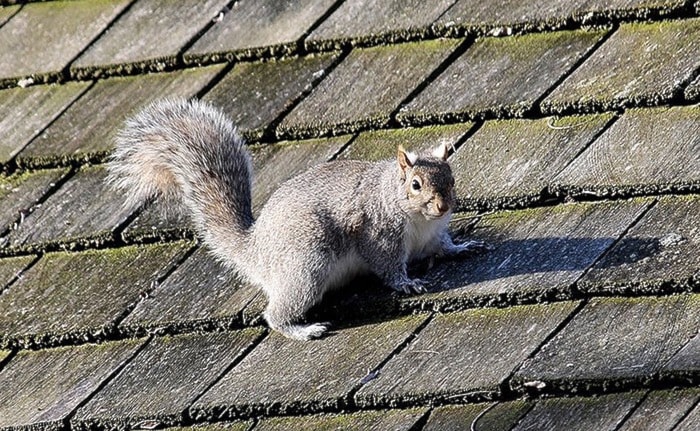Standing at my patio’s sliding glass door a couple weeks ago, I was stunned to see the cutest little squirrel rappel up my gazebo frame, then stop and sit there, looking right at me.
It was three to four feet from me, with a glass pane between us, and it stared at me while holding onto some type of food.
Within half a minute or so, I moved slightly and the little rascal leapt onto my roof and scampered away.
But the encounter got me wondering if the squirrel was getting into, and nesting in, my roof, somewhere.
And indeed he was.
It turns out there was a gap where one of the roof apex legs met the inclined roof, and the furry-tailed rodent had its front door to the attic.
I immediately remembered a television commercial of a mother typically calling at a bad time – during a spy’s gun fight and helicopter escape – to say, ‘The squirrels are in the attic again and your father says this time it’s personal.’
With spring around the corner, I knew it was only a matter of time before there would be a whole family living above the master bedroom – a very bad thing.
I knew I had to get it and get it fast.
This would be personal.
A little Internet sleuthing about trapping squirrels, and an informative visit to a local home-ware and hardware store or two, and I came home with a catch-and-release trap (roughly $40 locally) and a plan to capture and relocate my furry rodent friend — to a lush, bountiful forest on the other side of the river.
Experts say one common mistake many homeowners make is they block off the roof hole or roofline entrance the squirrels use, without ensuring the squirrel is out first, and that can create big problems.
Internet experts warn that squirrels can become trapped in the attic, ceilings and walls, then frantically attempt to get out by chewing on anything or everything in their way.
That could be sheetrock, wiring, drywall or anything else they think might be in the way. After a few days it is not uncommon for the squirrel to chew its way into the homeowner’s living space.
Pest-control professionals say trapped squirrels have chewed through living room ceilings in their efforts to escape.
Or worse yet, if the squirrel can’t get out, or get into the living area, it could die inside walls, the ceilings, or the attic.
This becomes a difficult situation for the homeowner.
It takes about two weeks for an odour to develop, and tracing its origin can be difficult to impossible.
The ceiling would have to be cut open to remove the dead squirrel.
But the question becomes: where do you start cutting?
All of this can easily be avoided by not blocking off a squirrel entrance.
So I baited my squirrel trap with a healthy dollop or two of peanut butter and some raw peanuts, then set the trap near the squirrel’s entrance into the roof. I used nylon rope to tie the trap to a rooftop vent so the squirrel couldn’t simply push it off.
They’re smarter than you think.
I would leave the trap, not checking on it until 24 hours later.
Sure enough, my little squirrel friend had visited my trap and helped itself to my bait offerings. But the trap was empty and its door remained set to go.
So I put in a homemade foil dish, wired to the trap, and left it again.
Early the next morning, I awoke to the sound of a struggle and rattling trap.
With some feeling of success and conquer, I got dressed and went up the ladder to see the little varmint trying to chew his way out of my trusty trap.
Then I placed him in the truck and drove him over the bridge, to a lush forest, and used my fireplace poker to open the trap and watch it scurry into the woods.
I replaced the trap on the roof, but there has been no activity for more than a week.
So the fascia-board gap will be filled this weekend.
Feeling some sense of accomplishment, I didn’t wait for mom’s call to tell her about it.
I called her.
– Kevin Gillies is a freelance writer for Black Press.
